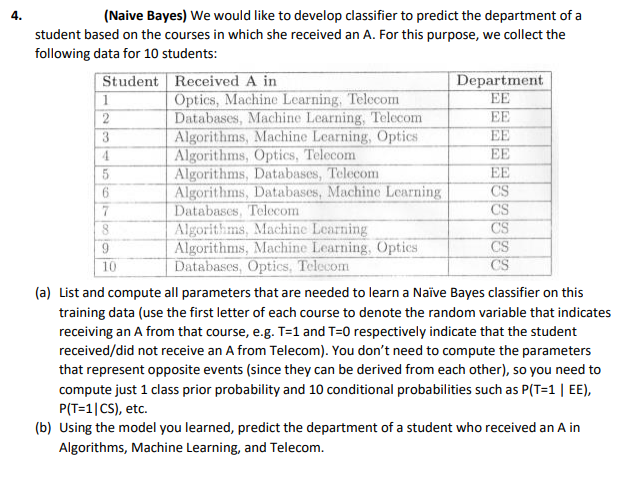(Naive Bayes) We would like to develop classifier to predict the department of a student based on the courses in which she received an A. For this purpose, we collect the following data for 10 students: Student Received A in Department EE EE EE EE EE Optics, Machine Learning, Telecom Databases, Machine Learning, Telecom Algorithms, Machine Learning, Optics Algorithms, Optics, Telecom Algorithms, Databases, Telecom Algorithms, Databases, Machine Learning Databases, Telecom Algorithms, Machine Learning Algorithms, Machine Learning, Optics Databases, Optics, Telecom 2 3. 4. CS CS 9. 10 CS CS CS (a) List and compute all parameters that are needed to learn a Naïve Bayes classifier on this training data (use the first letter of each course to denote the random variable that indicates receiving an A from that course, e.g. T=1 and T=0 respectively indicate that the student received/did not receive an A from Telecom). You don't need to compute the parameters that represent opposite events (since they can be derived from each other), so you need to compute just 1 class prior probability and 10 conditional probabilities such as P(T=1| EE), P(T=1|CS), etc. (b) Using the model you learned, predict the department of a student who received an A in Algorithms, Machine Learning, and Telecom.
(Naive Bayes) We would like to develop classifier to predict the department of a student based on the courses in which she received an A. For this purpose, we collect the following data for 10 students: Student Received A in Department EE EE EE EE EE Optics, Machine Learning, Telecom Databases, Machine Learning, Telecom Algorithms, Machine Learning, Optics Algorithms, Optics, Telecom Algorithms, Databases, Telecom Algorithms, Databases, Machine Learning Databases, Telecom Algorithms, Machine Learning Algorithms, Machine Learning, Optics Databases, Optics, Telecom 2 3. 4. CS CS 9. 10 CS CS CS (a) List and compute all parameters that are needed to learn a Naïve Bayes classifier on this training data (use the first letter of each course to denote the random variable that indicates receiving an A from that course, e.g. T=1 and T=0 respectively indicate that the student received/did not receive an A from Telecom). You don't need to compute the parameters that represent opposite events (since they can be derived from each other), so you need to compute just 1 class prior probability and 10 conditional probabilities such as P(T=1| EE), P(T=1|CS), etc. (b) Using the model you learned, predict the department of a student who received an A in Algorithms, Machine Learning, and Telecom.
Glencoe Algebra 1, Student Edition, 9780079039897, 0079039898, 2018
18th Edition
ISBN:9780079039897
Author:Carter
Publisher:Carter
Chapter10: Statistics
Section: Chapter Questions
Problem 13PT
Related questions
Question
100%

Transcribed Image Text:4.
(Naive Bayes) We would like to develop classifier to predict the department of a
student based on the courses in which she received an A. For this purpose, we collect the
following data for 10 students:
Student Received A in
Department
EE
EE
EE
EE
Optics, Machine Learning, Telecom
Databases, Machine Learning, Telecom
Algorithms, Machine Learning, Optics
Algorithms, Optics, Telecom
Algorithms, Databases, Telecom
Algorithms, Databases, Machine Learning
Databases, Telecom
Algorithms, Machine Learning
Algorithms, Machine Learning, Optics
Databases, Optics, Telecom
2
3.
4
5
EE
CS
CS
CS
CS
CS
10
(a) List and compute all parameters that are needed to learn a Naïve Bayes classifier on this
training data (use the first letter of each course to denote the random variable that indicates
receiving an A from that course, e.g. T=1 and T=0 respectively indicate that the student
received/did not receive an A from Telecom). You don't need to compute the parameters
that represent opposite events (since they can be derived from each other), so you need to
compute just 1 class prior probability and 10 conditional probabilities such as P(T=1 | EE),
P(T=1|CS), etc.
(b) Using the model you learned, predict the department of a student who received an A in
Algorithms, Machine Learning, and Telecom.
Expert Solution
This question has been solved!
Explore an expertly crafted, step-by-step solution for a thorough understanding of key concepts.
This is a popular solution!
Trending now
This is a popular solution!
Step by step
Solved in 3 steps

Recommended textbooks for you

Glencoe Algebra 1, Student Edition, 9780079039897…
Algebra
ISBN:
9780079039897
Author:
Carter
Publisher:
McGraw Hill


Glencoe Algebra 1, Student Edition, 9780079039897…
Algebra
ISBN:
9780079039897
Author:
Carter
Publisher:
McGraw Hill
